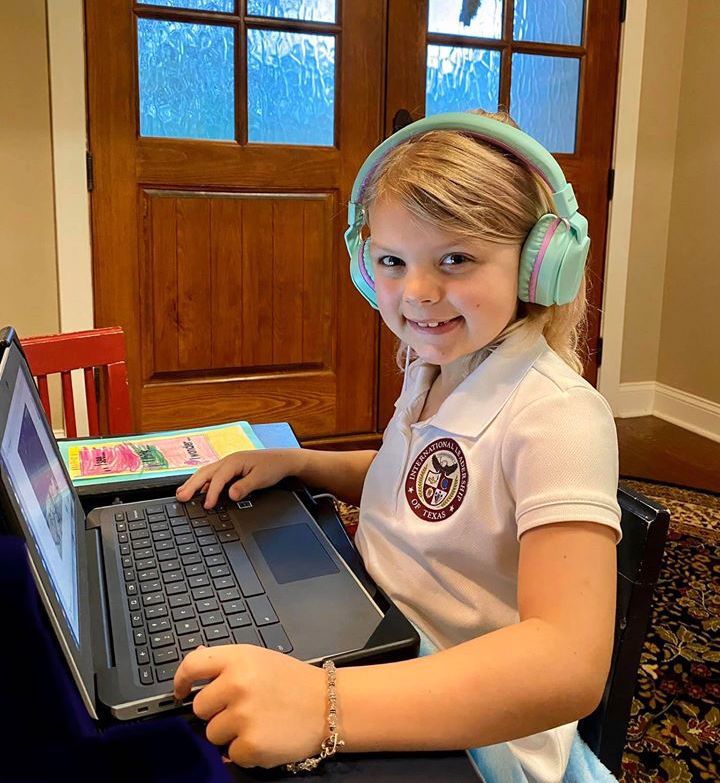Michael Wood, Manager, Education & Workforce
Forced to close for the remainder of the academic year due to the COVID-19 pandemic, Texas’ public and private schools introduced remote learning solutions to continue student education.
Three North Texas schools – International Leadership of Texas, Uplift Education, and Alcuin School – share how their organizations have approached the transition to virtual learning.
International Leadership of Texas (ILTexas)
Once it became evident that schools would remain closed beyond spring break, ILTexas Superintendent Eddie Conger began planning a “virtual school” model to replicate the normal school day as closely as possible. Conger wanted ILTexas students to see their classmates and interact with their teachers from the safety of their own homes.

Addressing potential gaps in technology access, the school purchased ChromeBooks for every kindergarten through third grade student – the only ILTexas students who did not already have school-issued devices – over spring break. The first week after the break, ILTexas offered independent study based off its existing learning platform to provide immediate access to learning resources. During this time, faculty and staff worked out the kinks in the virtual school model, test-running video conferencing tools, and hosting virtual “meet the teacher” nights.
The following week, ILTexas launched its virtual school. Students resumed their normal class schedule over video conference, beginning each day at 7:45 AM and even wearing their school uniforms. The novel approach to remote learning allows students to receive direct instruction from their teachers, and helps teachers recognize problems both inside and outside the virtual classroom.
The online school model has since seen minor adjustments, including shorter lessons to create more time for off-screen activities. Wednesdays have been converted into independent study days, whereby students check in with their first period class, and then have the rest of the day for hands-on project away from the computer. Wednesdays also afford teachers and students opportunities for tutoring and times for clubs/organizations to meet.
Although there will not be state standardized test results this year to assess student progress, engagement by ILTexas’s students and their parents suggest the model is working. In fact, some teachers remark that their attendance rates have never been higher, attributing the success to the routine the virtual school model provides students amid an uncertain crisis.
Uplift Education
When the pandemic began to threaten school closure, Uplift quickly pivoted to ensure minimal learning time was lost. Over spring break, Uplift’s leadership team recorded lessons from the school’s teachers for students to watch on YouTube in a remote setting. The next step was providing the student body with the tools to access this new learning platform. Uplift’s high school students already had access to devices, but the school was able to secure additional ChromeBooks to distribute to its students in third through eighth grade. This immediate response allowed the Uplift academic team to deeply think and plan for the next phase of remote learning.
The second phase offers elementary and middle school students much-needed structure through daily assignments, small group check-ins, and office hours with teachers. For the youngest learners, Uplift mailed detailed home packets for independent work or for use in conjunction with online lessons.
The district’s high school students are adhering to a schedule identical to their in-person school day. Recognizing the unique needs of students preparing for life after high school amid a crisis that has created much uncertainty, Uplift is providing access to an ACT preparation course for its juniors, and making one-on-one meetings with counselors available for its seniors as they prepare to transition to college, a career, or the military.
In addition to the obvious academic challenges, the crisis has also introduced social and emotional struggles for students. To provide further support, Uplift is offering a weekly session focused on social-emotional health for middle and high schoolers to mitigate stress.
Alcuin School
As a Montessori school, much of Alcuin’s curriculum hinges on tactile, hands-on learning – a model that is quite difficult to replicate away from the classroom. The school’s administration and teaching staff, however, have risen to the task to continue serving its students.
On the Friday of spring break, Alcuin’s teachers convened to chart out individual plans for delivering instruction from home and practice using video-conferencing software. Outside of a remote learning handbook for the school’s middle and high school classrooms, Alcuin has leaned on its teaching staff to innovate and adapt curriculum.
The school established basic daily structures for students based on age group. For the school’s youngest students, remote learning is facilitated through a partnership with parents, who receive guidance from their child’s teacher. Gradually, small group and full class instruction is added throughout the elementary grades. Alcuin’s fourth, fifth and sixth graders receive instruction through take-home materials, online learning tools, and frequent group sessions during abbreviated daily schedules.
Alcuin’s middle and high school students follow an abbreviated version of their normal school routine. Classes are an hour long and are each followed by a 30 minute break, designed to keep students better focused throughout the day.
Students may also engage outside the classroom through social and volunteer activities. Alcuin’s middle and high schoolers are able to volunteer across a variety of remote service opportunities, such as writing thank you notes for health care workers or reading to children.
Throughout the now nearly eight-week remote learning experiment, Dr. Joanne Chatlos, Alcuin’s Associate Head of School for Academics, has been impressed by her staff’s ability to adapt curriculum to meet the needs of the moment. In fact, some elements of the school’s crisis response, including more frequent small group instruction and increased parent engagement through social media, may stick around once the pandemic has passed.